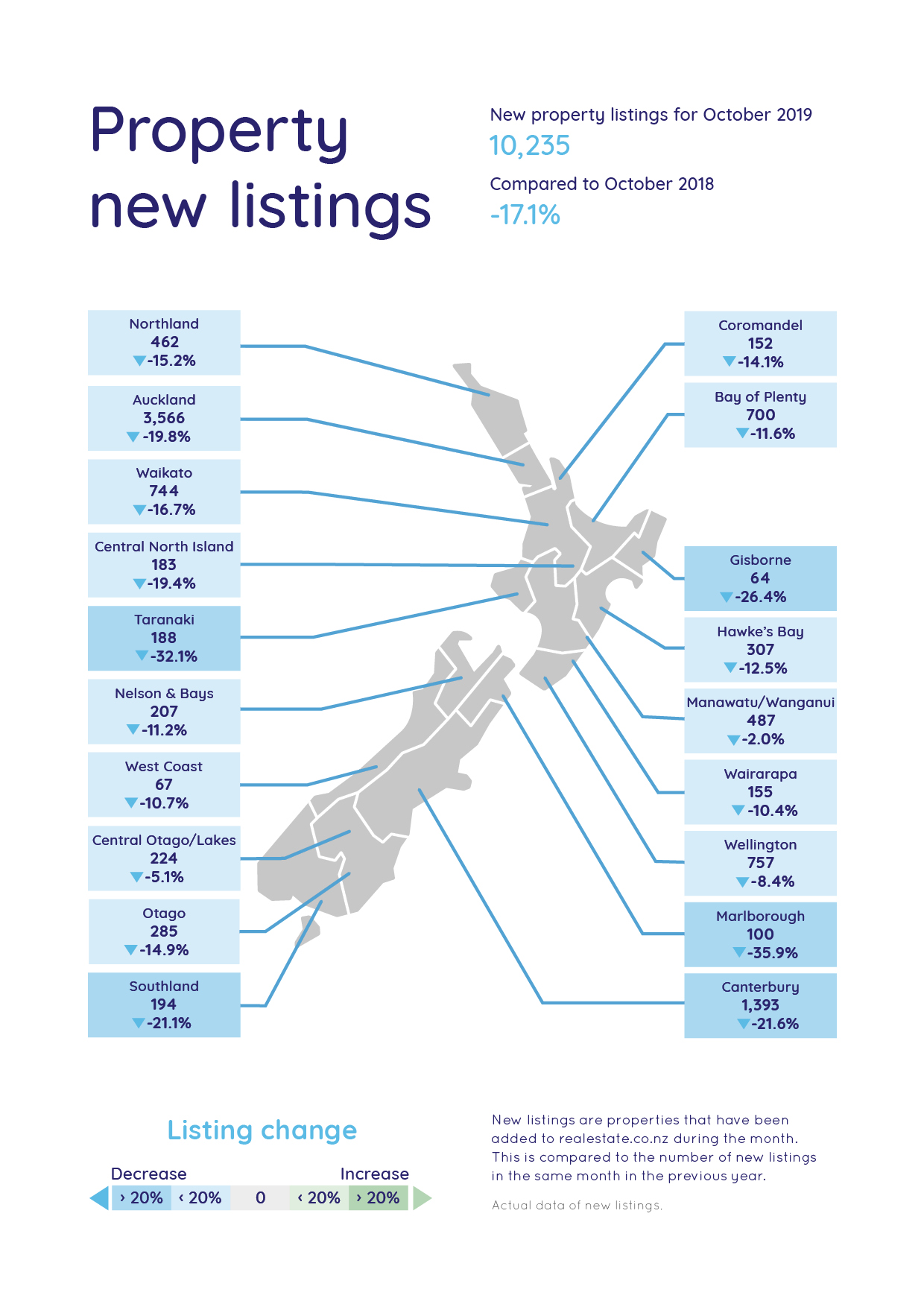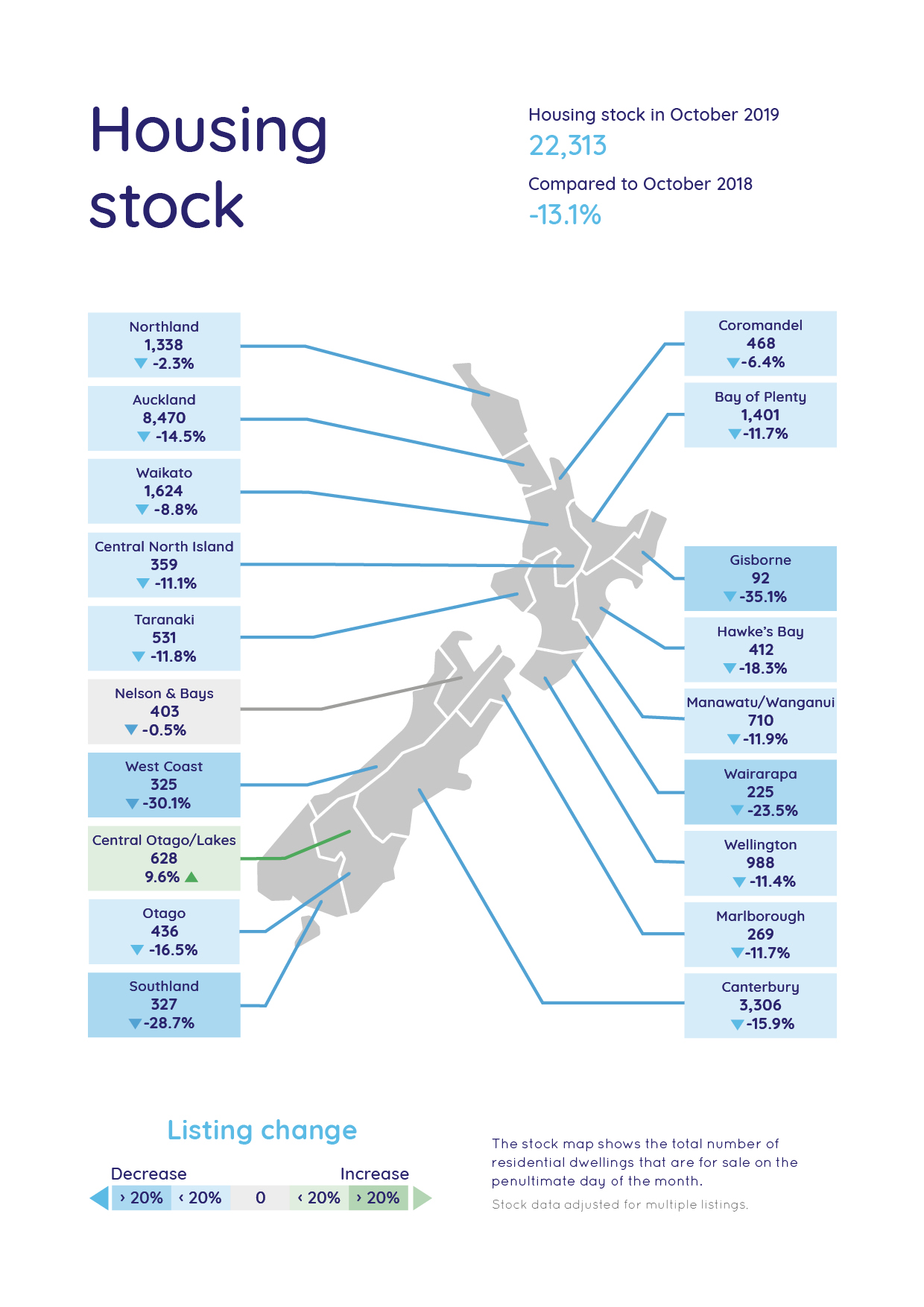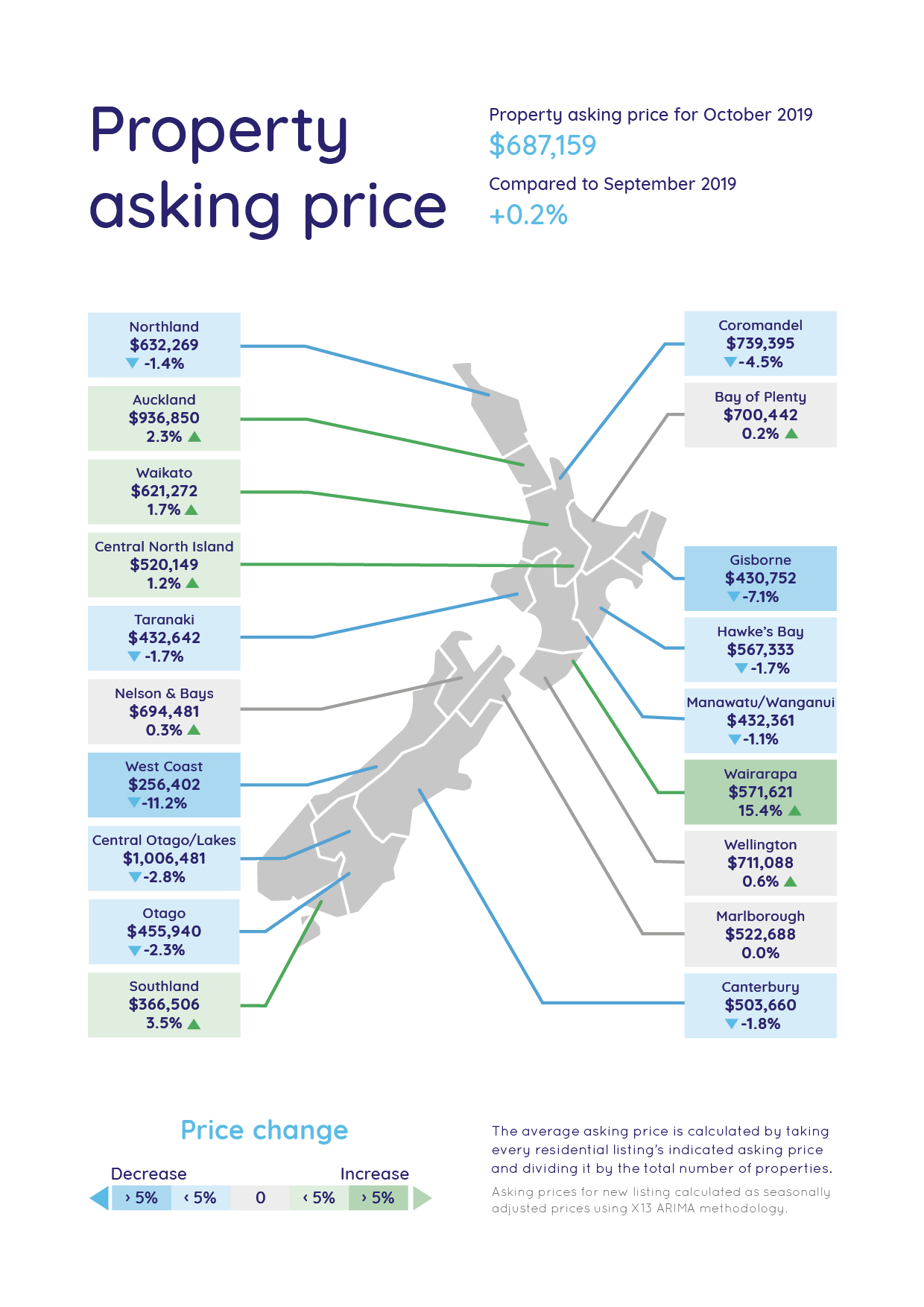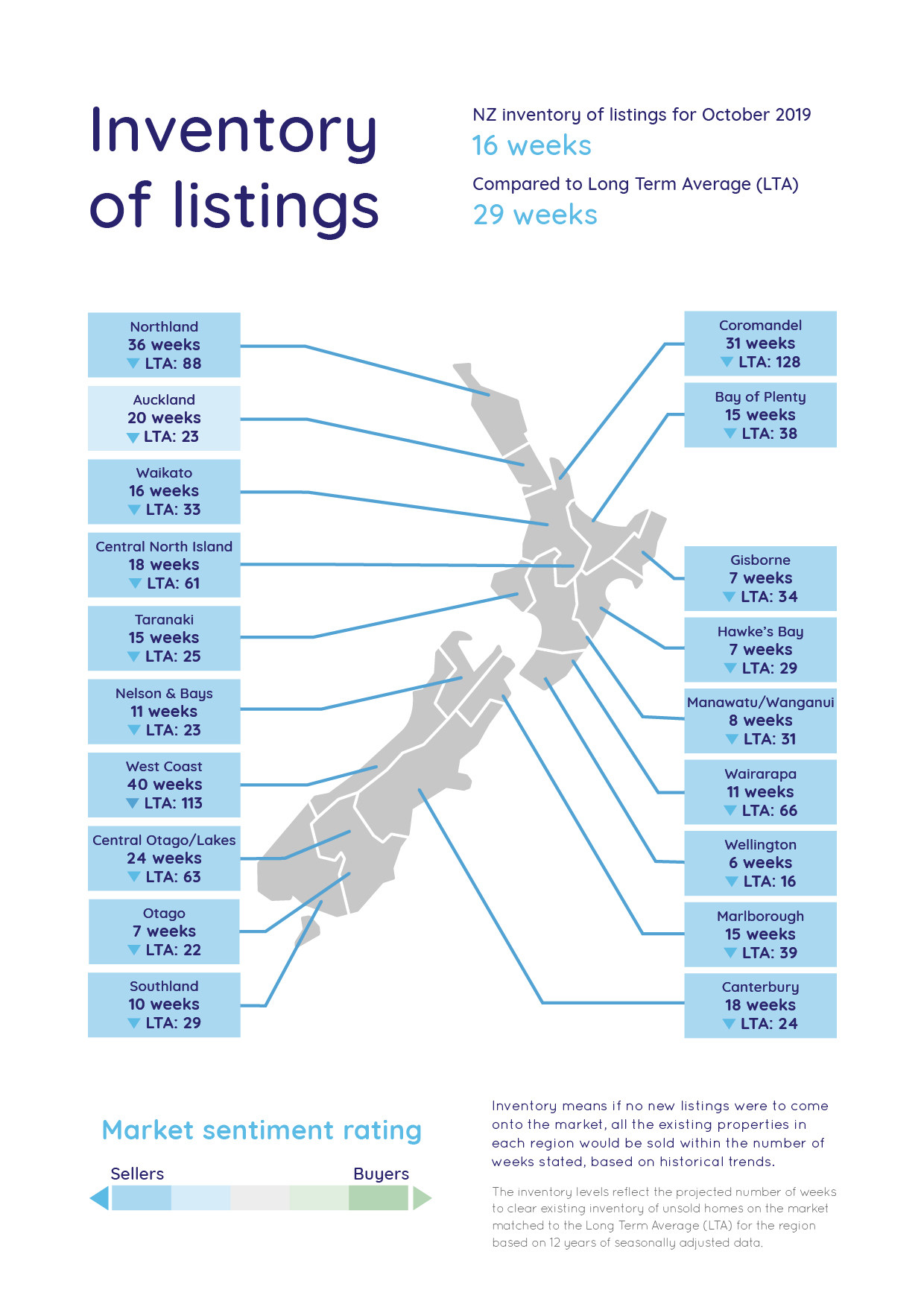Limited choice for New Zealand property seekers this spring. Five regions hit record asking price highs since data collection began in 2007, while the average asking price in the Bay of Plenty tips over $700k for the first time.
Download the full report as a PDF now.
Limited choice for New Zealand property seekers
Real-time data from realestate.co.nz shows Kiwi property seekers were squeezed for choice in October with fewer listings to choose from nationwide. Not only were new listings down nationally by 17.1% when compared to October 2018 but the total number of houses for sale were also down by 13.1% around the country.
In Auckland, new listings were down almost 20% with only 3,566 new properties coming onto the market during October.
Spokesperson from realestate.co.nz, Vanessa Taylor, says that Kiwis have been late to list for spring:
“While buyers remained active in October with more than 1 million unique users on realestate.co.nz, they certainly weren’t spoilt for choice. Throughout New Zealand, new listings and the total number of homes for sale were both down significantly compared to this time last year.”
New listings that came onto the market in October were down by 8.4% in Wellington (to 757 listings) and down 21.6% in Canterbury (to 1,393 listings), reflecting the overall decrease right across the country.

The total number of homes available for sale followed a similar trend. In Auckland, total listings were down 14.5% (to 8,470), in Wellington they were down 11.4% (to 988) and Canterbury saw a 15.9% decrease (to 3,306 listings) compared to the same time last year.
The only exception to buck the trend this month was the Central Otago/Lakes region, where the total number of homes for sale was up 9.6% (to 628 homes) compared to October 2018.
“When the number of new listings declines but the total number of homes available increases, it can suggest that homes are staying on the market for a bit longer than usual,” says Vanessa.
“In this case, it may be that those homes at the higher end of the market are taking a little longer to sell. This is consistent with the average asking price in the Central Otago/Lakes region still sitting over a million dollars.”

Average asking prices hit all-time highs in five regions since records began in 2007
Average asking prices were up around the country in October with the Bay of Plenty, Wellington, Nelson & Bays, Wairarapa and the Central North Island all hitting 13-year record highs.
Of these five regions, three saw only marginal increases of less than 2% while Wairarapa led the charge with a massive 15.4% increase in average asking price.
Reaching an unprecedented $571,621, last month’s asking price in the Wairarapa was over $50k more than the region’s last recorded high of $520,127 in August 2018.
“Average asking prices in the region have been below $500k since January 2019 so it will be interesting to see if this is the beginning of a new trend, or just an isolated spike like we saw in August 2018 and then again in December 2018, says Vanessa.
Real-time data from realestate.co.nz shows that the majority of those looking at property in the Wairarapa region are located in the Auckland or Wellington regions.
Vanessa says that this could suggest Kiwi city dwellers are seeking a lifestyle change:
“It could be that people from bigger cities have built up equity in their current homes and are keen to capitalise on it by making the food and wine region a place to call home.”
Vanessa says that the low stock levels could also be contributing to the rise in asking prices with the total number of homes for sale down by 23.5% (to 225 homes) compared to October last year.
“Supply and demand is likely having an impact here. As we know, an increase in demand and a decrease in supply tends to drive higher property prices.”
Bindi Norwell, Chief Executive at REINZ says: “With many parts of the country seeing record asking prices and record median selling prices, it’s surprising that listings continue to remain at such a low point considering we’re well into spring. This means that prices are likely to continue to rise across many parts of the country until we see more supply in the market.

Bay of Plenty region asking price rises above $700k for the first time
In the Bay of Plenty, New Zealand’s second fastest growing region, the average asking price tipped to $700,442 – the highest recorded average in 13 years since records began. While this is only a marginal increase on last month, the jump is a 9.7% increase on October 2018.
But property seekers had limited choice in the sought-after region during October. The total number of homes available for sale was down 11.7% giving those with bay dreams only 1,401 homes to choose from.
“Summer is just around the corner so it’s unsurprising to see so much interest in the region. With the weather getting warmer, who wouldn’t like a piece of Bay of Plenty paradise to call their own?” says Vanessa.
“Data from realestate.co.nz tells us that a large portion of those looking at property in the area are aged between 55 and 64 and are based in Auckland. This suggests that the Bay of Plenty, with its above average population of people aged 65 and over, is still very much the retiree’s dream.”
The impact of the new University of Waikato CBD campus on the property market is also something to watch, says Vanessa.
The University of Waikato, which has been active in the Bay of Plenty since the 1990s, opened its state-of-the-art Tauranga CBD campus in early 2019.
“It will be interesting to see if the increased prominence of the university will have a future impact in the property space.”
“We might, for example, see an increased interest in investment properties in the region in response to demand for student accommodation – some of those investors might even be parents of current or future students,” says Vanessa.

For media enquiries, please contact:
Trish Fitzsimons | 021 022 96927 | trish@realestate.co.nz
Glossary of terms: As the only provider of real estate data in real-time, realestate.co.nz offers valuable property market information not available from other sources.
- Average asking price is not a valuation. It is an indication of current market sentiment. Statistically, asking prices tend to correlate closely with the sales prices recorded in future months when those properties are sold. As it looks at different data, average asking prices may differ from recorded sales data released at the same time.
- Inventory is a measure of how long it would take, theoretically, to sell the current stock at current average rates of sale if no new properties were to be listed for sale. It provides a measure of the rate of turnover in the market.
- New listings are a record of all the new listings on realestate.co.nz for the relevant calendar month. As realestate.co.nz reflects 97% of all properties listed through registered estate agents in New Zealand, this gives a representative view of the New Zealand property market.
- Demand: the increase or decrease in the number of views per listing in that region, taken over a rolling three-month time frame, compared to the same three-month time frame the previous year – including the current month.
- Seasonal adjustment is a method realestate.co.nz uses to better represent the core underlying trend of the property market in New Zealand. This is done using methodology from the New Zealand Institute of Economic Research.
- Truncated mean is the method realestate.co.nz uses to provide statistically relevant asking prices. The top and bottom 10% of listings in each area are removed before the average is calculated, to prevent exceptional listings from providing false impressions.
01 Nov 2019

